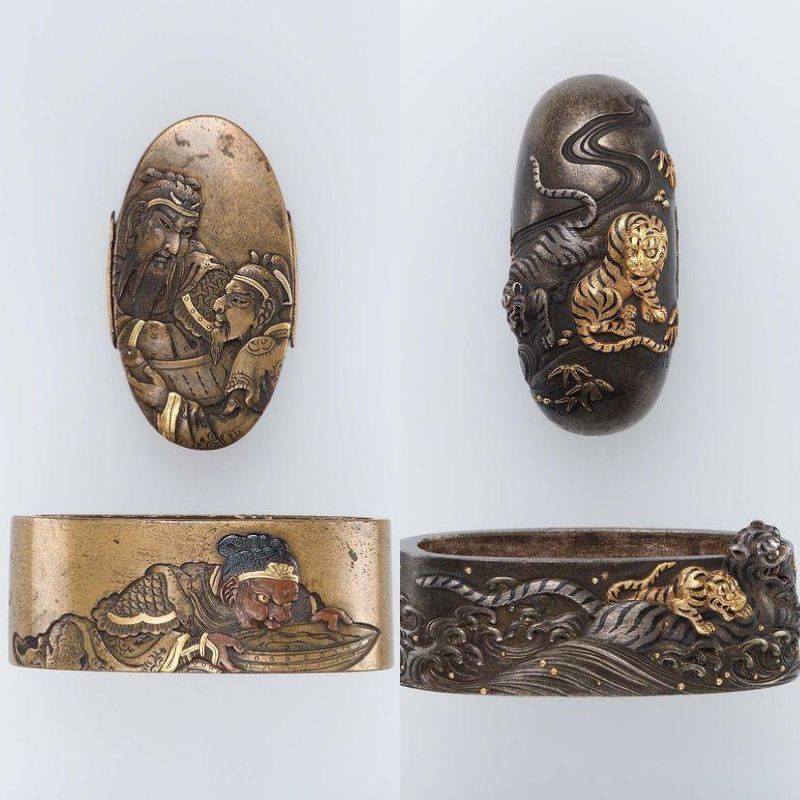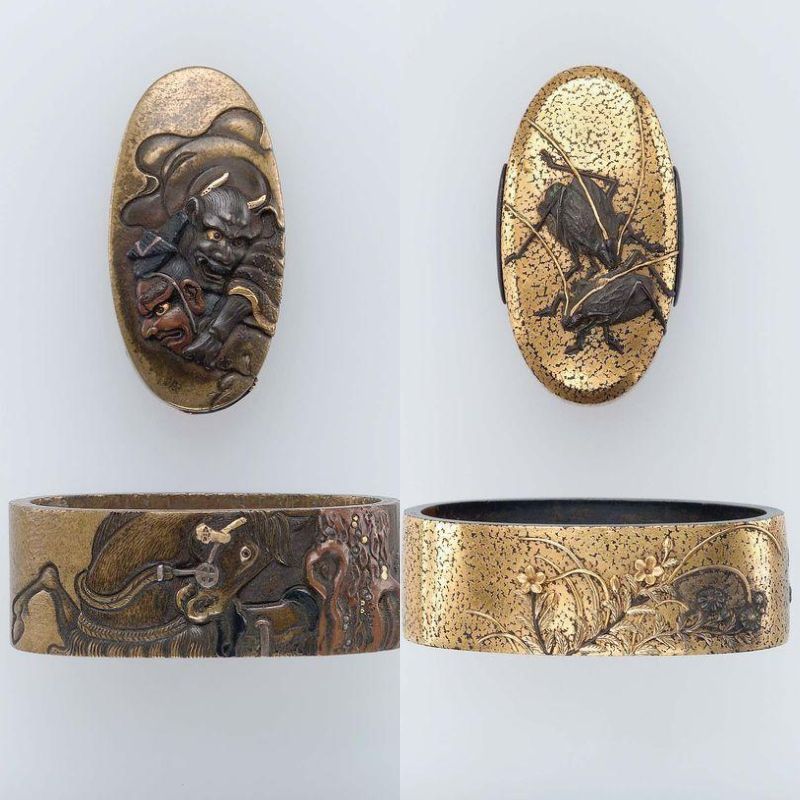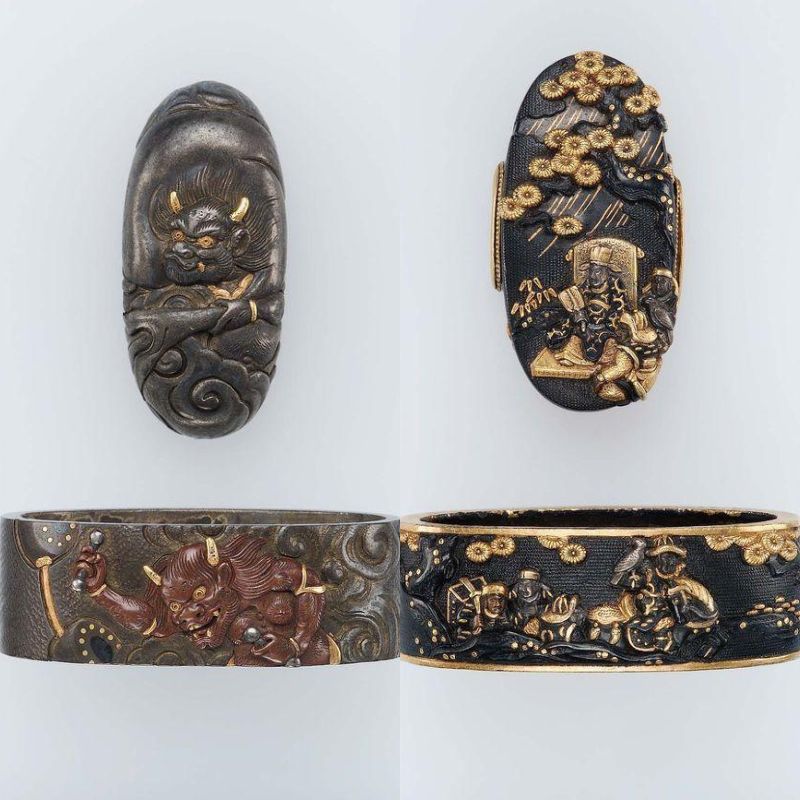Katana Fuchi - What is this part and common knowledge about it
Everything You Need To Know About Fuchi
Fuchi might not seem like that big of a deal to those who are not katana enthusiasts. However, it is one of Katana's most crucial parts because it serves multiple purposes. So, this article will cover everything you need to know about Fuchi.
Table of Content
- What Is Fuchi
- What's the Usage Of Fuchi?
- About the fuchi Design
- Commonly Used Materials For Fuchi Katana
- History Of The Katana Fuchi & Kashira
What Is Fuchi "緣"?

The Fuchi is the little metal ring that sits beneath the Tsuba. It enables both the decoration of the sword and the preservation of its designation. It is typically paired with the Tsuba and Kashira in style, as if the ensemble were telling a narrative. Fuchi in Japanese is 縁, it literally means "edge" or "rim".
The Fuchi caps the hardwood Tsuka's edge while completing the handle wrapping's beginning point. A bare metal band may serve as the Fuchi. However, in higher-end katana, the Fuchi may be a work of art created by skilled craftsmen. Typically, the Kashira will match Fuchi's theme. These two pieces combined are referred to as Fuchi-Kashira, or frequently matched sets.
What's the Usage Of Fuchi?
Fuchi protects the handle while also serving as a decorative accent. Furthermore, it helps to shield the katana's grip, or Tsukamaki, which helps keep the wood from cracking or breaking.
The katana Fuchi makes the hilt heavier. Thus, it helps to stabilize the blade and improves its maneuverability in battle. Two tiny pins (Mekugi), which also hold the Tsukamaki in place, fasten it securely to the sword's hilt.
An elevated ridge of lip is often present all around the edge of the katana fuchi. So, it aids in holding the grip in place. A pattern may also be etched or embossed onto the surface of the fuchi. Elements of nature frequently inspire such designs. These are, for instance, flowers or leaves, which can be highly detailed.
Well, the Fuchi functions not only as a helpful tool but also as a significant decorative component. It has the potential to demonstrate the status or riches of its bearer and is frequently among the sword's most intricate and ornamental details.
The exquisite motifs on the katana fuchi give it an additional degree of beauty and ornamentation. Thus, it completely turns it into a work of art. Furthermore, various designs were popular at multiple points in time. So, the fuchi is also a reliable predictor of the era during which an individual made the Katana.
About the fuchi Design
Regarding the design of both fuchi and kashira, just like other mountings (Koshirae) in the Japanese sword, the decorative patterns often feature animals, flowers, landscapes, deities, and so on. At the same time, the style and content of the patterns on the fuchi and kashira must also match and unify with the 'tsuba' (hand guard), 'saya' (scabbard), and the entire 'koshirae' (sword mounting) of the samurai sword.
The traditional fuchi and kashira design was often adapted the Japanese drawing style, focus on aesthetic conception, which means suggestion and implication are often valued over direct representation. This is heavily influenced by Chinese culture. Take this kashira and fuchi for example:

This theme is about the Japanese traditional god "Jurōjin", he is one of the one of the Seven Gods of Fortune (origin from China). Jurōjin is the god of longevity. In this fuchi and kashira set, instead of drawing the Jurōjin directly, the artist draws many relative elements such plum bossom, moon, cranes to show that this is about Jurōjin.
Enjoy more aesthetic Fuchikashira set:



Commonly Used Materials For Fuchi Katana
Different metals make up the majority of the Katana Fuchi Kashira. Copper, iron, or soft metal alloys are the specific metals that swordsmiths mainly use. With their distinct styles and themes, the Katana looks much better with more beautiful designs.
Brass, copper, and metal alloys are all acceptable materials. The fasteners are hand-produced to securely and firmly fit every handle.
Furthermore, manufacturers employ forged metal all over its dimensions to ensure that the Tsuka can maintain its shape. By doing this, one can guarantee it can survive the Tang's shocks.
History Of The Katana Fuchi & Kashira
In the original katana design, the purpose of fuchi and kashira are to increase the strength of the tsuka only. In the peaceful and prosperous Edo period, the society gradually stabilized and the business became more prosperous. At this time, the samurai sword emphasized the exquisiteness of the sword. And fuchi and kashira has gradually become more of a decoration.
In the Edo period, people gave the katana a symbolic meaning of the combination of Bushido and Confucianism. Only samurai are worthy of wearing a katana sword, while other low ranked samurai and ordinary people are not qualified to wear a katana. Therefore, the samurai sword has actually become a symbol of social class and identity.
Therefore, in order to show off their identity, it is common for a katana to have several tsukas at the same time. It has become a fashion for samurai to change the tsuka in order to match different clothes or attend different occasions. The connotation of the tsuka can reflect the ranking of the samurai, and the fuchi and kashira on the tsuka are one of the most important parts to show the charm of the tsuka.
Some of our fuchi & Kashira designs, if you want to add them to your custom katana check here:
Conclusion
By now, you should know all the necessary information regarding Fuchi. Hopefully, you've found this article helpful. Thanks for reading through.
*If you want to learn more about other katana parts, here is our guide























